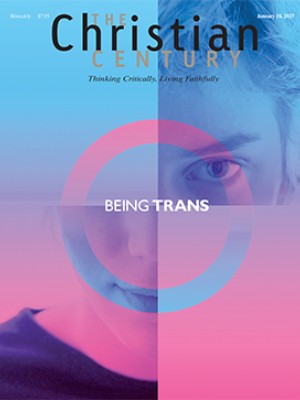Being a pastor for trans people
"A trans person's story has some unique elements, but the work of pastoral care remains essentially the same."

Tracy Nolan, a minister in the United Church of Christ, works with trans young people as a pediatric chaplain at Advocate Children’s Hospital in Park Ridge, Illinois. She has also served at a drop-in ministry in Chicago for LGBTQ youth.
How would you differentiate between these terms—sex, gender identity, gender expression, and sexual orientation?
Sex is typically assigned to each individual at birth based on a set of biological characteristics, such as chromosomes, reproductive organs, and hormones. But these biological categories aren’t always clear. Some people are born with biological characteristics that don’t fit the boxes: external or internal organs, hormone sensitivities, genetics, or other characteristics that don’t fit neatly into the categories male and female. The term intersex is used for folks in this category.
Read our latest issue or browse back issues.
Gender identity is an internal sense of self not assigned by someone else or connected to biological characteristics. It can be invisible.
Gender expression is the external manifestations of one’s gender identity. It’s what we show the world through our hair or clothes or mannerisms. Different cultures have different assumptions about what makes certain gender expressions “male” or “female.”
Sexual orientation is not dependent on gender identity. Sexual orientation is about physical, emotional, and romantic attraction; it answers the question “Who am I attracted to?” not “Who am I?”
Why do these different categories matter, and why is it important to keep them distinct?
We can cause people a lot of harm when we blur these categories. Sex may not match gender identity. Likewise, a gender identity doesn’t necessarily entail a particular sexual orientation.
We generally think of sex, gender identity, gender expression, and sexual orientation as fixed in some way. What does it mean that they are changeable or fluid?
It comes down to dissolving binary ways of thinking. Some people experience their gender or sexual orientation as set and unchanging. Others experience their gender or sexual orientation as changing: perhaps earlier in life they dated women and now they date female-to-male trans folks exclusively. Such persons may or may not say that their sexual orientation has changed. They may say that their sexual orientation is fluid. That doesn’t make their orientation less valid or real, nor does it make it a “phase.”
Similarly, not all people who identify as trans would say, “I knew from birth I was in the wrong body.” While some people experience their trans identity as linear and moving to an ultimate goal of being confirmed in their internal gender identity, others see their gender identity as something that changes or shifts, without a defined goal. A nonbinary and nonlinear understanding of gender identity challenges some core assumptions about gender and deeply challenges the language we use about gender.
American society has moved toward a greater acceptance and understanding of gay and lesbian people and of the idea that same-sex attraction is the result of sexual orientation. Does that move help or hinder people in understanding transgender people?
The idea of a “sexual orientation” implies something fixed and unchangeable. It brings to mind arguments like “I was born this way.” While this argument has helped trans folks gain acceptance in some ways, it has hindered other trans folks from finding acceptance, since not all trans folks would identify with the idea of transitioning from one gender to the opposite binary gender.
People distressed with the sex or gender assigned them at birth are said to experience gender dysphoria. Is it helpful or problematic that gender dysphoria is an official psychiatric diagnosis according to the latest edition of the Diagnostic and Statistical Manual of Mental Disorders?
What is now categorized as gender dysphoria used to be called gender identity disorder. The move away from “disorder” language was seen by many people as a positive step, but some people feel that listing trans experience as a psychiatric diagnosis at all, whether as “dysphoria” or a “disorder,” pathologizes trans identity. Others see the current category as an imperfect solution to the need for medical language that allows insurance companies to cover gender surgeries.
What’s at stake for transgender teenagers who are told which school bathrooms they can and can’t use?
Transgender teens could better answer this question than I can. But broadly speaking, there’s a lot at stake. To be told by someone that “you don’t belong here” in the most basic level of human functioning—going to the bathroom—is to be told you aren’t worth making space for. It’s important to empower young people to speak about their needs and to listen to them. Making space to meet someone’s needs is a way of loving them and telling them they are lovable and worthy. The rhetoric that surrounds some conversations about bathrooms and trans folks creates a toxic environment not only for trans folks but for every person in that community.
In your experience, what role has religious belief played for people undergoing gender transitions?
I have met some young people who felt religion was totally irrelevant to their understanding of their gender identity. Others experience religion and gender identity as connected, sometimes positively and sometimes negatively. Sometimes faith has been a helpful way to mark transition points; other times it has felt like a hindrance in transitioning. I would encourage pastors simply to listen well to each person they encounter.
How can a minister be helpful to transgender people who seek pastoral care?
When talking to a person who identifies as trans, use the pronouns and name that the person asks you to use. When in doubt, ask. If you make a mistake, apologize and move on.
Consider how you might be perceived as a minister. Identify yourself as a safe person through your language and interaction.
Don’t assume that someone who identifies as trans is broken or needs pity.
Pay attention to how you might advocate for someone—but first offer and ask their permission. Some may not want your advocacy, or it might not be safe for them to be public about their trans identity.
Don’t “out” anyone. Their story is theirs to share, and they may not share it with everyone for very valid reasons.
A trans person’s story has some unique elements, but the work of pastoral care remains essentially the same for all: exploring people’s understanding of themselves, the world, and God; noticing emotions, experiences, grief, joy, and the impact of self-understanding on relationships and life events; and considering areas of support, whether that of a biological or chosen family, friends, mentors, counselors, role models, online communities, teachers, or a faith community.
What are some of the lessons you’ve learned from working with gender nonconforming and transgender patients?
I’ve learned not to assume that someone is in need of help (healing, reconciliation, or advocacy) just because they identify as trans. People are resilient. Trans folks have figured out how to thrive in a world whose gender norms often grate against their very existence. There’s a lot of strength already present in trans folks, and reminding people of their resilience is an important pastoral task in itself.
How might Christians support the safety and health of transgender people, both those who are public about their experience and those who are not?
Ministers can consider how gender is listed on church forms, used in hymns, or impacts youth programming. Preachers can refer to trans identities in their sermons in an affirming and normalizing way. Church bathrooms can be unisex or family. A trans flag can be added next to the rainbow flag on the church marquee. Churches can participate in or host events with trans organizations.
At the local, regional, national, and international levels, Christians can support policy, legislation, and human rights standards that uphold the rights of individuals who identify as transgender. This might mean engaging in conversations at the school board to encourage policies that respect trans students, supporting an advocacy organization in letter writing, or advocating for insurance coverage for gender confirmation surgery on church health insurance plans.
A version of this article appears in the January 18 print edition under the title “Ministry with trans people.”







